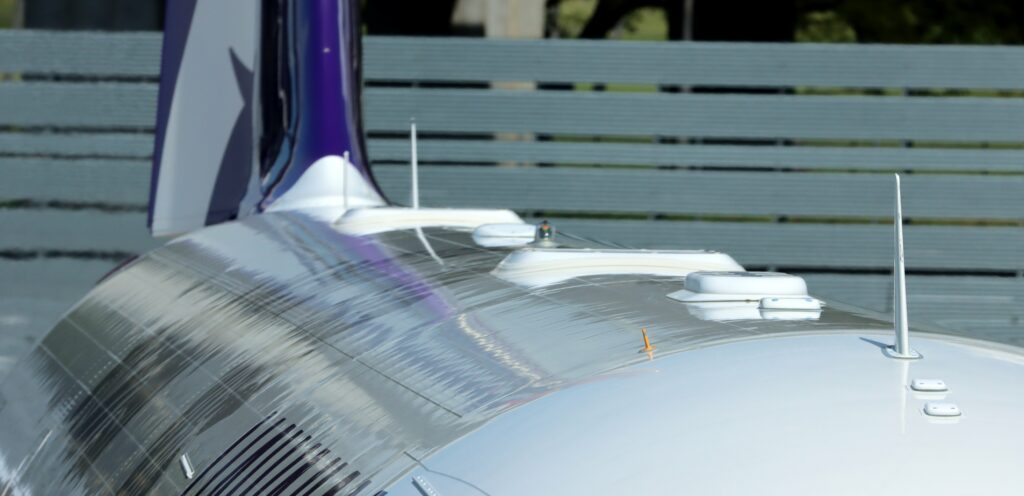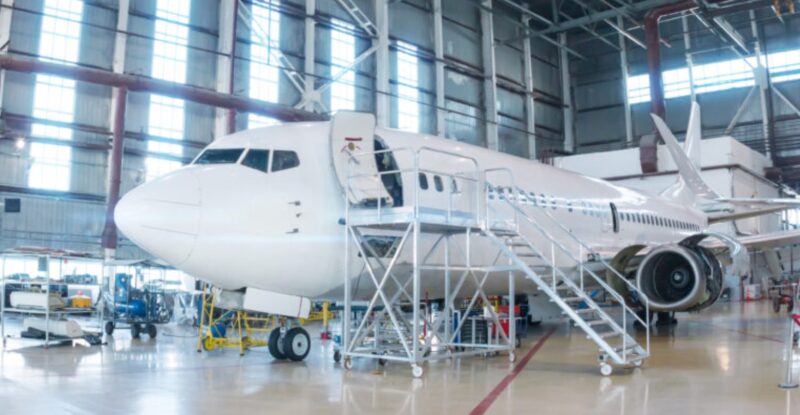Panasonic Avionics recently announced it has selected Intellian Technologies’ electronically steerable antenna (ESA) to serve as an augment for its existing Global Communications Suite (GCS), which powers geostationary satellite-based inflight connectivity for airlines using a gimbaled antenna installed on roughly 2,500 aircraft today. The low-cost, lightweight, easy-to-install Intellian ESA, which talks to Eutelsat OneWeb’s Low Earth Orbit (LEO) satellite network and has already proven itself in maritime and other industries, will also support a new standalone LEO-only inflight connectivity service from Panasonic.
But even as it works to bring these new options to customers, Panasonic is pressing ahead with the rollout of LEO/GEO inflight connectivity utilizing Gilat’s popular multi-orbit Stellar Blu ESA, including as a retrofit option — for which it has secured new airline customers — and as a Boeing linefit option once offerability is formally granted by the US airframer. And it remains fully committed to the nextgen multi-orbit ESA solution, Panasonic Avionics vice president connectivity business unit John Wade confirms to Runway Girl Network.
Indeed, the firm’s new partnership with Intellian “does not take away from anything we do with Stellar Blu today. So, Stellar Blu is still very much a very important part of our portfolio,” Wade says.
“There are areas today where you don’t have LEO coverage. And so, any airline looking to fly where there isn’t LEO coverage, this [Gilat Stellar Blu multi-orbit ESA] is the natural antenna for them, and it’s also the antenna we’re moving forward with linefit on. So, I’m sure you’re aware that Stellar Blu has got a very active integration program with Boeing, and we’re very much committed to that.”
Boeing has indeed advanced its work to offer the Gilat Stellar Blu multi-orbit ESA as a linefit option for airlines. And during this year’s Aircraft Interiors Expo in Hamburg, it showcased a half-scale model of a new shroud-like structure that would ensure compatibility with existing provisions. SES, which acquired Intelsat this summer, is using the same hardware to deliver multi-orbit IFC inclusive of Eutelsat OneWeb LEO service, and believes its LEO/GEO IFC offering will be linefit offerable at Boeing by 2026 when equipped 737 MAX twinjets are expected to be delivered to Japan Airlines. Panasonic, meanwhile, is eyeing a 2027 debut for its linefit multi-orbit service, utilizing the same kit.
“[W]e’re working very closely with both BCA and BGS to look at solutions that will allow true linefit and also for the option to upgrade Boeing aircraft to install Stellar Blu onto existing airplanes,” Wade notes of the firm’s engagement with Boeing Commercial Airplanes and Boeing Global Services. “So that’s still a very active program.” BGS is expected to facilitate post-delivery 787 retrofits via Service Bulletins, as SES-formerly-Intelsat previously revealed to RGN.
Panasonic is also moving full speed ahead to support the aircraft retrofit market, and in fact has won at least five airline customers for the multi-orbit IFC offering, utilizing the Gilat Stellar Blu ESA, including previously-announced Discover Airlines. Installs with one carrier are already underway, Wade confirms, and Panasonic has been gleaning “a lot of good flight-test information from the airline that’s been installed and has been using on a daily basis.”
Of note, Panasonic reckons that airlines “have clearly spoken by saying that they want LEO, that low latency matters, and we agree with them.” Indeed, a not immaterial number of the 2,500 aircraft fitted with Panasonic’s traditional GEO-based GCS solution today are defecting to SpaceX’s Starlink LEO-focused IFC offering, though Panasonic expects to hold onto “a fleet size considerably over 1,000 airplanes,” giving it a robust addressable market for the 70-pound Intellian ESA augment option.
Starlink has proven to be disruptive on a number of fronts, however, including with its introduction of a two-antenna configuration for narrowbody and widebody aircraft.
“Five years ago, if you had told all of us longtime IFC guys that you could put more than one antenna on top of an airplane to do IFC, we’d have all looked at you and said, ‘No, you can’t. No airline is ever going to accept that,” Wade says.
“Well, all that knowledge of the IFC guys have been proven wrong. So, it became pretty clear, when Starlink entered the market, that in fact airlines would accept a second antenna.”

Two Starlink terminals blend into the collection of antennae atop a Hawaiian Airlines A321neo Image: Seth Miller
For airlines that carry Panasonic’s GEO-focused GCS solution today but want the benefit of LEO, and “don’t want to spend hundreds of thousands of dollars in installing a second antenna to give them the full capability of the OneWeb network,” then Panasonic can offer them “the most affordable path to getting to multi-orbit, and from that perspective, we’re just delighted with” the Intellian ESA, Wade says .
“And the secondary market, then, is LEO-only. We are seeing a number of airlines that are now saying, ‘we don’t need GEO because we’ve got all the coverage and capacity we need out of OneWeb. So can’t we do this more affordably?’ And now we’ve got an antenna that says, ‘yeah, you can.'”
As to whether Panasonic could envisage securing new customers for the GCS gimbaled antenna-plus-Intellian ESA antenna configuration, Wade says, “I don’t think so. You know, the gimbaled antenna technology, I think it was great for its era. It was great for its time. It did what we needed it to do. But I really think that we’re coming to the end of gimbaled antennas.
“And so while there might be a few airlines that currently continue to take GCS, I think most airlines today would look at what we can do with a solid state antenna” whether it’s Gilat’s Stellar Blu multi-orbit ESA or Intellian’s LEO ESA. “They really see the solid state antennas as being the way of the future. So I think it would only be an edge case…”
Related Articles:
- Panasonic Avionics adds LEO-only IFC antenna including for GEO augment
- Air Canada extols virtues of SES multi-orbit IFC, nears E175 installs
- Discover Airlines pivots from GEO to LEO/GEO with Panasonic on A330s
Featured image credited to istock.com/Dushlik












